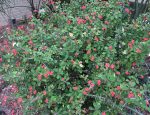 Native to Madagascar, this evergreen semi-succulent shrub is a member of the spurge family, Euphorbaceae, that also includes pointsettia, croton, and castor oil plant. The plants grow up to 6′ tall and have thick fleshy grayish-brown stems that are branched, 3-5 angled, and covered with 1″ long spines/thorns. The obobate , bright green to gray-green leaves are up to 6″ong, arranged sprirally, and are tend to be just on the branch tips. The inconspicuous flowers are 1″ wide, have showy yellow or red bracts, and may bloom all year. Plants are useful in containers and hedges as well as for xeriscaping in rock gardens and seaside gardens. All parts of the plant are poisonous if ingested and the milky sap from the stems may irritate the skin. The plant is considered to be sacred in the Bathouist religion of the Bodo people of Assam, West Bengal, Nagaland and Nepal and symbolises the supreme deity, Bathoubwrai (Master of the Five Elements). The genus name, Euphorbia, honors Euphorbus, the ancient Greek herbalist and personal physician of Juba II, King of Mauretania, an area in North Africa. The specific epithet, milii, honors M. le baron Milius, Governor of Île Bourbon, present-day Île de la Réunion (Reunion Island) who may have introduced the plant into France in 1821. The varietal name, splendens, comes from the Latin word splendeo meaning shine.
Native to Madagascar, this evergreen semi-succulent shrub is a member of the spurge family, Euphorbaceae, that also includes pointsettia, croton, and castor oil plant. The plants grow up to 6′ tall and have thick fleshy grayish-brown stems that are branched, 3-5 angled, and covered with 1″ long spines/thorns. The obobate , bright green to gray-green leaves are up to 6″ong, arranged sprirally, and are tend to be just on the branch tips. The inconspicuous flowers are 1″ wide, have showy yellow or red bracts, and may bloom all year. Plants are useful in containers and hedges as well as for xeriscaping in rock gardens and seaside gardens. All parts of the plant are poisonous if ingested and the milky sap from the stems may irritate the skin. The plant is considered to be sacred in the Bathouist religion of the Bodo people of Assam, West Bengal, Nagaland and Nepal and symbolises the supreme deity, Bathoubwrai (Master of the Five Elements). The genus name, Euphorbia, honors Euphorbus, the ancient Greek herbalist and personal physician of Juba II, King of Mauretania, an area in North Africa. The specific epithet, milii, honors M. le baron Milius, Governor of Île Bourbon, present-day Île de la Réunion (Reunion Island) who may have introduced the plant into France in 1821. The varietal name, splendens, comes from the Latin word splendeo meaning shine.
Type: Evergreen semi-succulent shrub
Outstanding Feature: Colorful bracts; reference to crucifixion
Form: Rounded
Growth Rate: Slow
Bloom: Inconspicuous flowers surrounded by colorful red to orange bracts all year long
Size: 6′ H
Light: Full sun to partial shade
Soil: Sandy, well-drained; drought tolerant
Hardiness: Zones 9-10
Care:If grown as a house plant feed 10:10:10 weakly weekly and reduce water in the winter.
Pests and Diseases: None of significance
Propagation: Stem cuttings
Photo Credit: Chhe Wikipedia